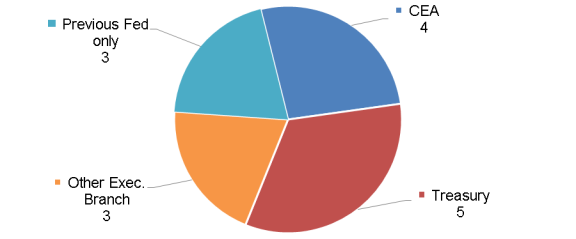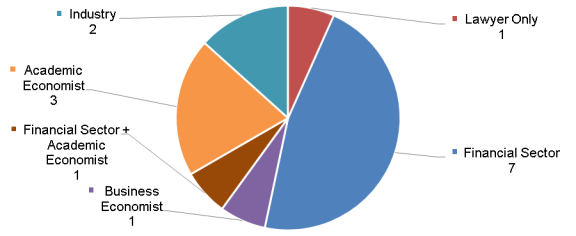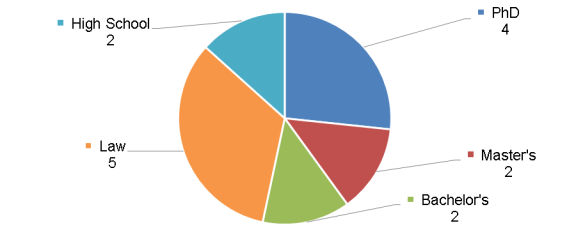Janet Yellen's term as Federal Reserve (Fed) Chair expires February 3, 2018. Subject to Senate confirmation, President Trump may reappoint her or nominate another individual to replace her. This Insight reviews the reappointment and background of previous Fed Chairs.
The qualification requirements to serve in Fed leadership are general—statute requires the President to "have due regard to a fair representation of the financial, agricultural, industrial, and commercial interests, and geographical divisions of the country." Yellen and her immediate predecessor, Ben Bernanke, had similar backgrounds—both were PhD economists with previous experience at the Fed, in the executive branch (both were Chair of the Council of Economic Advisers), and in academia. Since the Fed's beginning in 1914, the 15 Fed Chairs have had diverse educational and professional backgrounds.
For background on the Fed, the nation's central bank, see CRS In Focus IF10054, Introduction to Financial Services: The Federal Reserve, by Marc Labonte.
Reappointment
The President appoints Fed governors to a 14-year term, subject to Senate confirmation. Governors may not be reappointed after having served one complete 14-year term, but may be reappointed if they served out only the partial remainder of a term. The President appoints one of the governors as Chair, subject to Senate confirmation, for a 4-year renewable term. A fixed term with reappointment for the Chair was not added to the Federal Reserve Act until 1935.
Overall, six of eight Chairs eligible for reappointment—including five of the last six Fed Chairs preceding Chair Yellen—were reappointed at least once, as shown in Table 1. Four were reappointed by a different President—in each case, by Presidents from different parties for at least one of their terms. The two Chairs not to be reappointed at least once were (1) G. William Miller, who left the Fed to become Treasury Secretary, and (2) Thomas McCabe, who was forced to resign over policy differences.
If not reappointed as Chair, Yellen could choose to remain on the board until her term as governor expires in 2024, but this is rare. The last Chair to do so was Marriner Eccles, who was not reappointed as Chair in 1948, but remained as governor until 1951. Three other Chairs could potentially have been reappointed to additional terms, but were not. According to Allan Meltzer's A History of the Federal Reserve, Arthur Burns was not reappointed to a third term by President Carter and Paul Volcker did not seek a third term. Ben Bernanke did not seek a third term, according to his autobiography. (Alan Greenspan and William McChesney Martin Jr. were not eligible to serve additional terms.)
Table 1. Fed Chair Appointments
|
Federal Reserve Chair
|
Years Served as Chair
|
Appointing/Reappointing President
(Year Term Began)
|
|
Janet Yellen
|
2014-present
|
Obama (2014)
|
|
Ben Bernanke
|
2006-2014
|
George W. Bush (2006), Obama (2010)
|
|
Alan Greenspan
|
1987-2006
|
Reagan (1987), George H. W. Bush (1992), Clinton (1996, 2000), George W. Bush (2004)
|
|
Paul Volcker
|
1979-1987
|
Carter (1979), Reagan (1983)
|
|
G. William Miller
|
1978-1979
|
Carter (1978)
|
|
Arthur Burns
|
1970-1978
|
Nixon (1970, 1974)
|
|
William McChesney Martin, Jr.
|
1951-1970
|
Truman (1951), Eisenhower (1956, 1959), Kennedy (1963), Lyndon Johnson (1967)
|
|
Thomas McCabe
|
1948-1951
|
Truman (1948)
|
|
Marriner Eccles
|
1934-1948
|
Franklin Roosevelt (1934, 1935, 1940, 1944)
|
|
Eugene Black
|
1933-1934
|
Franklin Roosevelt (1933)
|
|
Eugene Meyer
|
1930-1933
|
Hoover (1930)
|
|
Roy Young
|
1927-1930
|
Coolidge (1927)
|
|
Daniel Crissinger
|
1923-1927
|
Harding (1923)
|
|
William Harding
|
1916–1922
|
Wilson (1916)
|
|
Charles Hamlin
|
1914-1916
|
Wilson (1914)
|
Sources: Senate nominations database of the Legislative Information System, Congressional Record, and news articles.
Notes: A fixed term with reappointment for the Chair was not added to the Federal Reserve Act until 1935 (P.L. 74-305, 49 Stat. 684). The Chair position was referred to as governor before 1935.
Federal Reserve Experience
Excluding Charles Hamlin, the first Fed Chair, 9 of the 14 Fed Chairs had prior experience at the Fed's Board of Governors or one of the 12 regional Federal Reserve Banks. Alan Greenspan (1987-2006) was the most recent Fed Chair with no previous Fed experience.
Federal Policymaking Experience
All 15 Fed Chairs had prior federal government policymaking experience, including at the Fed. Figure 1 shows that 12 (and all since 1934) had previous policymaking experience outside the Fed, most commonly with the Treasury Department (including the Office of the Comptroller of the Currency) or the Council of Economic Advisers (CEA).
|
Figure 1. Executive Branch Experience of Fed Chairs
|
 |
|
Source: Congressional Research Service (CRS) using data from Federal Reserve History webpage, congressional nomination hearings, obituaries, and Marquis Who's Who.
Note: Some Chairs who had previously worked at the Council of Economic Advisers (CEA) and Treasury Department also had other executive branch experience.
|
Private-Sector Experience
All of the Fed Chairs previously worked in the private sector, including academia. As seen in Figure 2, their experience varied. Eight worked in the financial sector, most commonly at banks. Five of the last six Chairs (excluding G. William Miller) worked as economists in academia or the private sector; none of the first nine Chairs worked as economists. Among noneconomists, seven were financial-sector executives (e.g., bank presidents) and two were nonfinancial-sector business executives in their most recent private-sector experience prior to becoming Fed Chairs. Several worked as lawyers, but only one had no private-sector experience outside of the law.
|
Figure 2. Selected Private-Sector Experience of Fed Chairs
|
 |
|
Source: CRS using data from Federal Reserve History webpage, congressional nomination hearings, obituaries, and Marquis Who's Who.
|
Educational Background
The last three Fed Chairs have been PhD economists, but this was rare before then. As shown in Figure 3, the most common educational attainment among previous Chairs was a law degree. Before 1970, some previous Chairs' highest educational attainment was a bachelor's degree or high school diploma, respectively.
|
Figure 3. Highest Educational Attainment of Fed Chairs
|
 |
|
Source: CRS using data from Federal Reserve History webpage, congressional nomination hearings, obituaries, and Marquis Who's Who.
|


